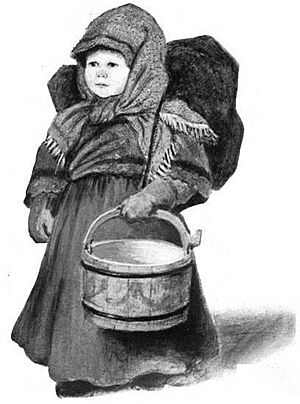Lisbeth Longfrock facts for kids
Lisbeth Longfrock (original title: Sidsel Sidsærk og andre kjærringemner) is a classic Norwegian book written by Hans Aanrud. It was first published in 1903. The story was translated into English in 1907 by Laura E. Poulsson and featured drawings by Norwegian artist Othar Holmboe. Later, in 1935, it was translated again with the title Sidsel Longskirt: A Girl of Norway. This version had famous illustrations by Ingri and Edgar Parin d'Aulaire.
The Story of Lisbeth
The book tells the story of its main character, Lisbeth, from when she is a child until her confirmation. After her mother passes away, Lisbeth moves from her first home, New Ridge farm, to Hoel farm. New Ridge farm was known as "Peerout Castle" because it had a great view of the valley. Lisbeth gets the nickname Longskirt (or Sidsærk in Norwegian) because of a very long skirt she received as a Christmas gift from her brother.
Her brother, Jacob, also leaves home to become a herdsman at Nordrum farm. At Hoel farm, Lisbeth is looked after by Kjersti Hoel, the farm's owner. Kjersti had promised Lisbeth's mother she would care for her. Lisbeth works with the farm animals, both at the main farm and at the seter. A seter is a mountain pasture used during the summer months. While at the seter, Lisbeth meets two other herdsmen from nearby farms. She spends the summer with them, getting to know them as she grows up.
The book shows the challenges faced by children who worked in the countryside. These children often lived far from their parents and had to work hard. Even with these tough conditions, the story has a hopeful and positive feeling.
How the Story is Told
Like most of Hans Aanrud's stories, Lisbeth Longfrock is set in Eastern Norway, which is similar to the author's own home area of Gausdal. In its first Norwegian version, the book used local dialects, but this effect is often lost when translated into English.
Aanrud writes the story from an "omniscient third-person perspective." This means the narrator knows everything about all the characters and what they are thinking and feeling. He describes a countryside community in a very realistic and balanced way. In his tales, farmers are shown as caring and kind, and children from humble backgrounds are given chances to grow and develop.
The author focuses on describing nature, farm traditions, and good qualities like enjoying your work and having a strong sense of duty. There's also a touching moment in the chapter where Lisbeth and her brother meet again a year after their mother's death.
Aanrud became well-known for his realistic and down-to-earth descriptions of country life in his home valley before the industrial age. He shows how ordinary farmers thought and spoke through simple, friendly conversations, sometimes using dialect. The landscapes are described beautifully, creating a strong atmosphere. Most parts of the stories are funny, but sometimes there are also sad moments. The characters, the plot, and the descriptions of the land always fit together perfectly.
Often, children are the main characters in Aanrud's stories, which made them popular children’s books. However, Aanrud himself had actually written these tales for older readers.
A street in Oslo, Norway, called Sidsel Sidsærks vei, is named after this famous book.
External Links
- Read Lisbeth Longfrock for free at Project Gutenberg.
- Find Lisbeth Longfrock at Google Books.


